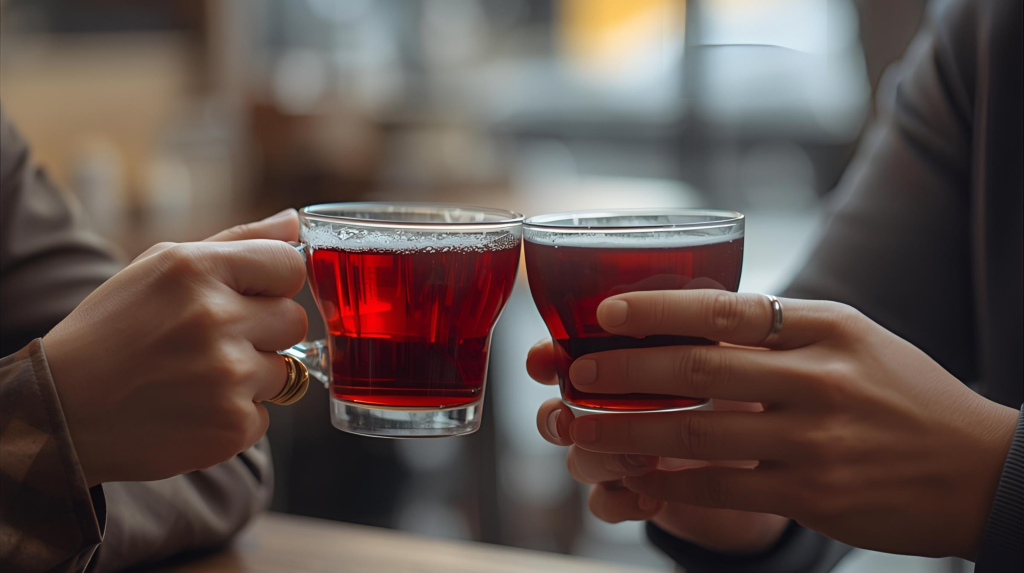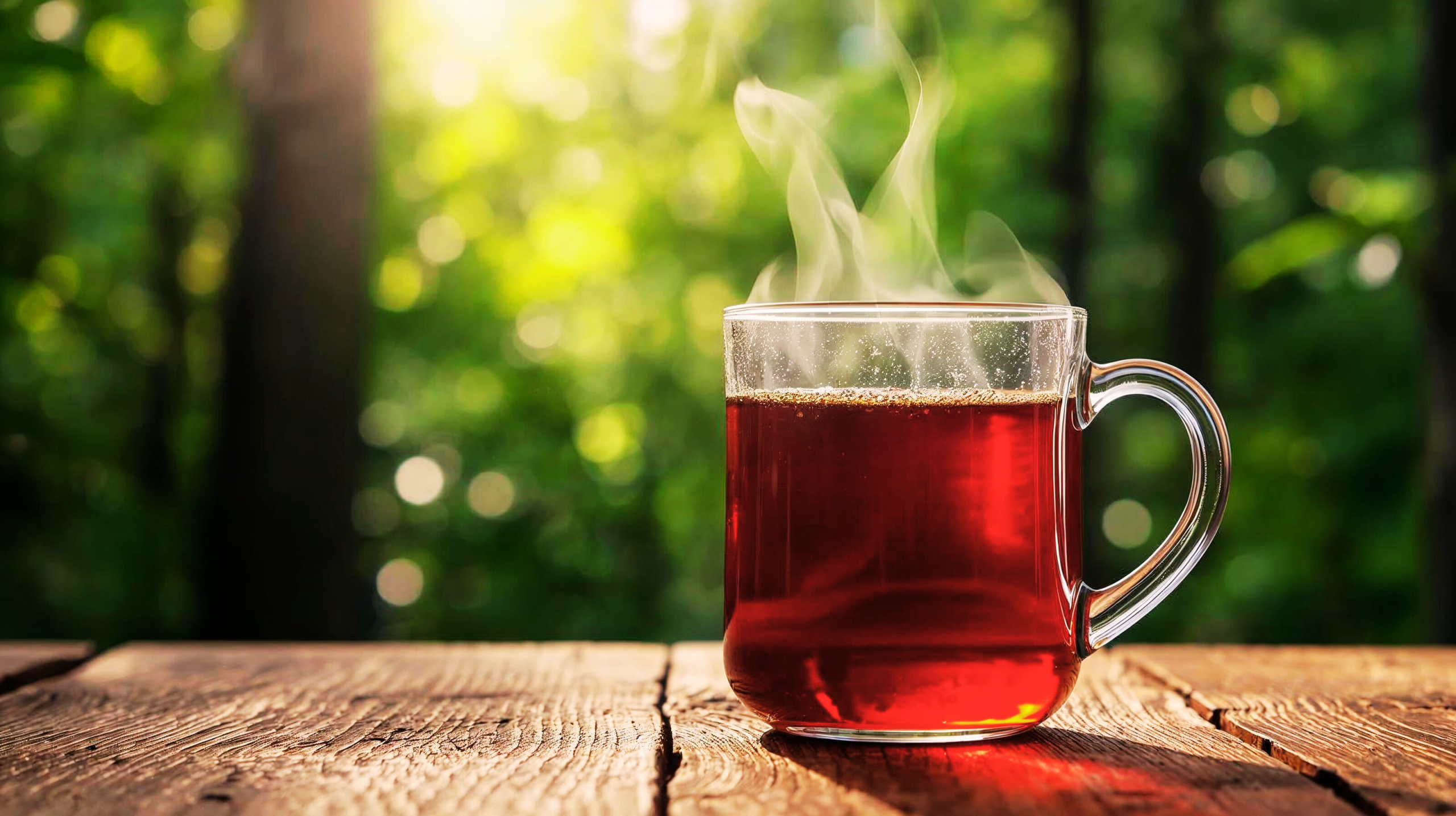If you’re hearing about red tea more and more lately — good. Because this isn’t just trendy; it might actually deserve the hype. Red tea (in many contexts) refers to rooibos — a caffeine-free herbal infusion from South Africa. But heads up: sometimes people loosely call hibiscus tea or certain black teas “red” in color “red tea”, so always check what type someone’s talking about. In this article, I focus on true rooibos red tea, its benefits, and practical uses — because I believe this tea can deliver more than just a cozy sip.
What Is Rooibos (Red) Tea?
- Origin & Plant: Rooibos (Aspalathus linearis) is a shrub native to the Western Cape region of South Africa. Its leaves are harvested, bruised, and fermented to produce the classic “red” version; there is also a green (unfermented) rooibos, which retains more antioxidants. (Medical News Today)
- Flavor & Properties: Rooibos has a naturally sweet, earthy, somewhat nutty flavor. Because of the fermentation process, the red version has richer, deeper flavor; green rooibos tastes lighter and more vegetal. It’s naturally caffeine-free and low in tannins. (Healthline)
What Makes The Red Tea So Powerful — Key Health Benefits
Yes, red tea (rooibos) packs a punch. But before you start downing six mugs a day, there are limits — some claims are better supported than others. Let’s separate what is solid from what’s hopeful.
- High in Antioxidants
Rooibos contains several powerful antioxidants, including aspalathin, nothofagin, and quercetin. These help neutralize free radicals, reduce oxidative stress, and may lower risk of chronic disease. (Medical News Today) - Heart Health
There are human studies showing rooibos can improve cholesterol profiles (lowering LDL, raising HDL), reduce blood pressure, possibly via inhibition of the ACE (angiotensin-converting enzyme). That’s important, because high blood pressure and poor lipid profiles are among the biggest contributors to heart disease. (Medical News Today) - Blood Sugar Regulation & Diabetes Support
Some evidence (animal studies + smaller human‐intervention trials) suggests rooibos helps improve blood glucose control, increase insulin sensitivity, reduce markers of vascular damage in diabetes. The antioxidant aspalathin seems especially relevant here. (Medical News Today) - Anti-inflammatory & Immune Support
Rooibos has compounds with anti-inflammatory effects. It may modulate immune response, reduce markers of inflammation, and help with oxidative damage in organs (liver, etc.). (Memorial Sloan Kettering Cancer Center) - Better Sleep & Stress Relief
Since it’s caffeine-free, rooibos is a smart evening drink. Some studies show it may lower cortisol (the “stress hormone”) and provide a calming ritual, which by itself might help with sleep and mental rest. (Cansa) - Skin & Aging Benefits (Promising, but less proven)
Topical applications or dietary use might help reduce oxidative damage in skin, possibly help reduce signs of aging. But human data is limited. (Medical News Today)
Uses & How to Use The Red Tea
Here’s how people use red tea / rooibos, with tips for getting the most out of it.
- Drinking Hot or Cold: Brew like other teas. Use boiling water for red rooibos, steep for 5-10 minutes (yes, longer steeps may bring out more flavor and antioxidants). Let it cool for iced tea. (Medical News Today)
- Blends & Flavored Teas: Rooibos blends well with vanilla, cinnamon, fruits, citrus, mint. Since its base taste is mellow, these additions can be enjoyable.
- Latte / Milk Tea Version: Because it’s naturally sweet, gives you room to add milk (dairy or plant-based) without needing much sugar.
- Topical Uses: Some skincare formulations use rooibos extract for its antioxidant / anti‐inflammatory properties. If doing this, ensure you’re using properly prepared extract and patch test first.
Red Tea Possible Drawbacks & Safety Notes
I believe in being real: red tea/rooibos is great, but it’s not magic. Here are what you should watch out for:
- Most human studies are small, varied, or short-term. The effects (especially for serious conditions) are promising but not definitive.
- Rare cases of liver toxicity have been reported with large or long-term intake. If you have liver issues, proceed with caution. (Memorial Sloan Kettering Cancer Center)
- Because rooibos can influence ACE enzymes and has estrogenic effects in some lab studies, people on ACE inhibitor medications, or with hormone-sensitive conditions (like certain breast cancers), should consult their healthcare provider. (Memorial Sloan Kettering Cancer Center)
- As always: what you add (sugar, milk) can turn a healthy cup into a high-calorie, high-sugar drink.
- Don’t let red tea replace medical treatment. Use it as support / wellness tool, not cure.

Where to Get High-Quality Rooibos (Red Tea) & What to Look For
If you’re going to recommend this, or use this yourself, quality matters.
| What to Look For | Why It Matters |
|---|---|
| “Certified organic” rooibos | Reduces risk of pesticide/residue contamination. |
| Fermented (red) vs unfermented (green) | Green has more of certain antioxidants; red has deeper flavor & more traditional processing. |
| Loose leaf & whole‐leaf | Often fresher, more potent, fewer additives compared to tea bags. |
| Trusted brands / origins | Rooibos from South Africa (Cederberg region) tends to be considered best; some brands may mix or dilute. |
| Freshness & packaging | Airtight, protected from light / moisture– those degrade flavor and potency. |
Places to buy:
- Natural food stores (Whole Foods, Sprouts) often have rooibos both loose-leaf and in tea bags.
- Online tea specialists – many small tea companies offer single-origin rooibos or organic certified.
- Amazon / Etsy, with scrutiny (check reviews, origin).
- Specialty import shops carrying South African goods.
Conclusion
Red tea (rooibos) isn’t just another herbal fad. It’s a legit wellness tool: caffeine-free, rich in unique antioxidants, supportive of heart health, blood sugar balance, and more. But (and this is key) it’s not a miracle drug. Use it smartly—choose quality, don’t overload, combine it with healthy lifestyle choices—diet, sleep, movement—and you’ll likely see benefits.
References
- Afrifa D, et al. “The health benefits of rooibos tea in humans (Aspalathus linearis) – a scoping review.” PMC (2023). (PMC)
- Medical News Today. “Rooibos tea: benefits, nutrition, and how to drink it.” (Medical News Today)
- Healthline. “Rooibos Tea: Health Benefits and Side Effects.” (Healthline)
- WebMD. “Health Benefits of Rooibos.” (WebMD)
- MSKCC (Memorial Sloan Kettering). Rooibos Tea – Herb / Integrative Medicine. (Memorial Sloan Kettering Cancer Center)
FAQ
Q: Is red tea the same as green tea or black tea?
A: No. Green and black tea are made from Camellia sinensis, contain caffeine, and have more tannins. Rooibos comes from a different plant, is naturally caffeine-free, and lower in tannins.
Q: How many cups a day is safe / optimal?
A: Most studies used between about 200-1200 ml per day (≈ 1-5 cups, depending on size). If you don’t have kidney, liver, or hormone-sensitive issues, 2-5 cups seems reasonable. Always listen to your body.
Q: Can I drink red tea at night?
A: Yes. Because it’s caffeine-free, it’s ideal for evening use. Plus, the ritual of sipping something warm, relaxing, supports good sleep routines.
Q: Does it help with weight loss?
A: There is some evidence it can support weight management via improving fat metabolism, increasing antioxidant status, etc. But it’s not a magic bullet. Without proper diet + activity, it won’t do much.
Q: Are there people who should avoid it?
A: Yes. If you have liver disease, on certain medications (ACE inhibitors, hormone therapies), or hormone-sensitive cancers, talk to a physician before regular, high-dose use.
